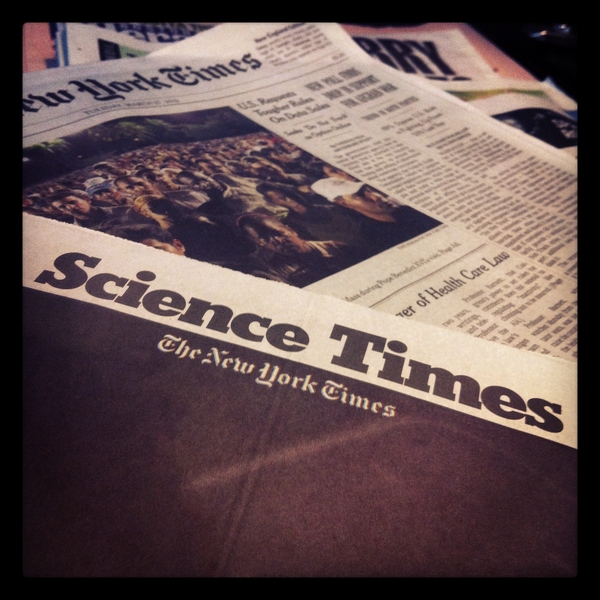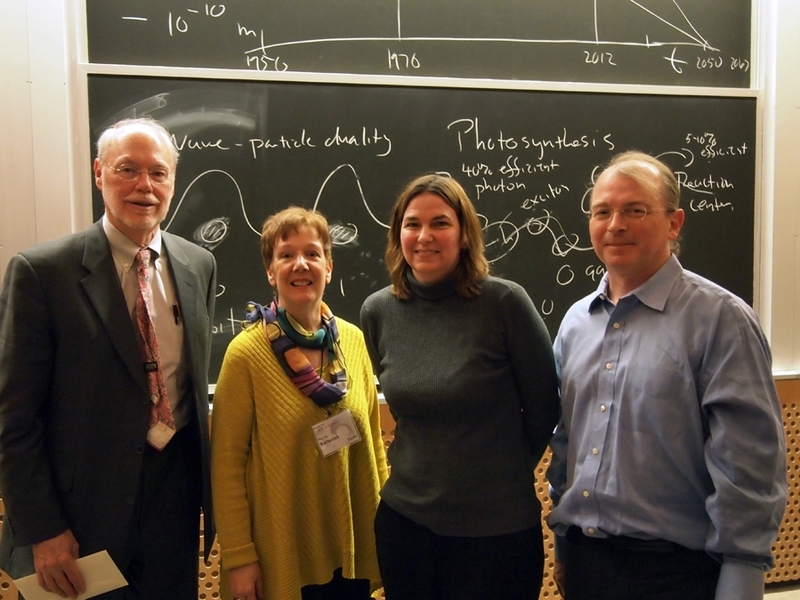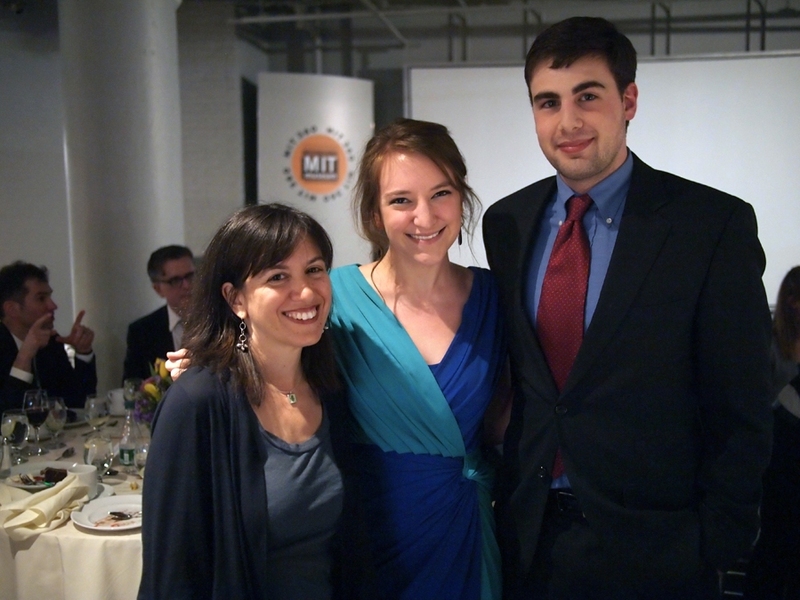The MIT Graduate Program in Science Writing turns 10 this year, and this Saturday saw many of the program’s 61 alumni back on campus to catch up and reminisce with fellow graduates, professors and mentors.
A daylong symposium, titled “Telling the Stories of Science,” was a celebration of the past 10 years of science writing at MIT, but the day’s ending events focused on the future — the future of science, and the future of science writing. One panel explored the current state of play in the study of brains, learning and memory; a second explored the 50-year future of three of the most significant current stories in science: molecular biology, nanotechnology and quantum computing.
The future of science
MIT professors Phillip Sharp, Angela Belcher and Seth Lloyd each took a turn predicting what the future holds for their respective fields — first looking at how far they’ve come today.
When Belcher first asked, years ago, if it might be possible to give genetic information to inanimate objects, one colleague said she was insane and the other said there was no way she could do it.
When Lloyd started down the path to quantum computing in the 1980s, he had a tough time getting a job in what someone told him was “a field for only crackpots and Nobel laureates that have gone soft.”
And when James Watson and Francis Crick discovered DNA in 1953, did they have any idea what the future held for the field they had started?
“Jim Watson — I had lunch with him a few days ago, and I can tell you for certain they did not know what was going to happen with molecular biology,” said Sharp, an Institute Professor in the Department of Biology.
All three told of surprises their fields held.
Belcher, the W.M. Keck Professor of Energy in MIT’s Department of Materials Science and Engineering, spoke of powerful batteries made of viruses engineered by members of her group, solar cells that clean themselves, medical needles that don’t hurt — not to mention antibacterial socks that don’t smell — all inventions based on nanotechnology. “You can give genetic information to materials,” she said, holding up a virus-based battery that visited the White House a few years ago.
Lloyd, a professor of mechanical engineering and of engineering systems, and his colleagues have created dozens of simple devices that use quantum computing — the exploitation (or empowerment, as Lloyd prefers to put it) of electrons’ quantum mechanical ability to be in two places at once — to “compute in ways you can’t with classical computers,” he said.
Sharp described the changes in biology within MIT, from the establishment of the modern gene-based biology department in the 1950s to the addition of biology as a core science requirement in 1993 to the creation of the David H. Koch Institute for Integrative Cancer Research in 2010. “You see the evolution of life science from DNA to more complex issues, more societal issues,” he said.
All three speakers emphasized the roles their fields would play in the challenges facing society in the next 50 years and beyond.
Engineering plants through molecular biology is the much-needed next revolution in agriculture, Sharp said, pointing to a world population that is expected to reach 9 billion around 2050. “If we don’t feed them, they’re going to start wars,” he said.
Sharp also sees improvements in health care as a likely success in the future — and an additional challenge. “It’s going to work, and that’s going to be a bigger problem than you think it is,” he said. “You’re going to have your genome on your iPad.” With such insight into health and aging, Sharp said, life expectancy will increase, and when people live longer, the challenges associated with population growth will become even greater.
Belcher peered ahead to energy, healthcare and the environment in 2062, seeing nanoparticles that can find tumors and yeast engineered to sequester carbon dioxide — concepts that have already been developed. “I’m thinking about where we are right now, and where we need to be to make the planet a better place,” Belcher said. “Nanotechnology has a huge role to play.”
To Lloyd, our world is changing not only with time, but with the knowledge we gain. “That’s why so much that was unexpected has shown up,” he said. “Every time we increase the resolution of how we can look at things, we expand our horizons.”
Yet no matter what the future of science holds, Lloyd said that science writing would have an important role to play. “These problems are political,” Lloyd said in response to an audience question after the talk. “Unless we as scientists push, and unless you as people writing about science tell people what is going on, we won’t have enough to solve the problems.”
The future of science writing
The world is changing, not just for scientists, but for science writers as well. At a dinner at the MIT Museum later that evening, Pulitzer Prize-winning New York Times science writer Amy Harmon and host Kurt Andersen of the radio show “Studio 360” discussed changes in science and media that are reshaping the role of science journalism.
“I think that science journalism is more important now than maybe ever. We’re facing such challenges in science, and I don’t need to tell the people in this room that,” Harmon said. “There are some very powerful people who don’t think climate change exists. Communicating the truth about science is so important, and that means telling people stories so they want to hear them.”
Harmon and her editors have gotten creative to bring stories to life; a recent article in her ongoing series about adults and autism integrated video with print online. “It’s a different kind of journalism,” she said. “It’s not two different ways of telling a story, it’s trying to tell the story as a whole.”
On the arts and culture-themed “Studio 360,” Andersen sees a similar fusion of science with topics listeners might relate to more easily. “It’s never purely about science, it’s always about science and how these disciplines interact,” Andersen said.
As newspaper science sections shrink, Robert Kanigel, professor of science writing and co-founder of the Graduate Program in Science Writing, noted that this kind of integration of science into life and culture has become more common.
Host Seth Mnookin, a lecturer in the science writing program, added, “I find it scary when places like The New York Times get rid of science reporters and don’t seem to have any plan to replace them or to retain that knowledge.”
Even as science writers face challenges in the changing world of journalism, new developments in media have opened new possibilities. Mnookin asked Andersen and Harmon for their thoughts on Twitter; both described it as a powerful tool.
“In the digital glut of stuff that’s been created in the last 50 years, I find it an incredibly helpful gatekeeper to stories,” Andersen said.
“There’s this community I would never have been able to reach otherwise,” Harmon added.
MIT Science Writing (@MIT_Sciwrite) tweeted happily during the dinner when Andersen said, “I think we’re living in what may be an early golden age of science writing, even if it doesn’t call itself science writing.”
That’s good news for the program, and as Tom Levenson, professor of science writing and director of the Graduate Program in Science Writing, said at the dinner, “We’ve had a great 10 years so far, and we hope and intend to have a great many more, and many more strong students to come.”
A daylong symposium, titled “Telling the Stories of Science,” was a celebration of the past 10 years of science writing at MIT, but the day’s ending events focused on the future — the future of science, and the future of science writing. One panel explored the current state of play in the study of brains, learning and memory; a second explored the 50-year future of three of the most significant current stories in science: molecular biology, nanotechnology and quantum computing.
The future of science
MIT professors Phillip Sharp, Angela Belcher and Seth Lloyd each took a turn predicting what the future holds for their respective fields — first looking at how far they’ve come today.
When Belcher first asked, years ago, if it might be possible to give genetic information to inanimate objects, one colleague said she was insane and the other said there was no way she could do it.
When Lloyd started down the path to quantum computing in the 1980s, he had a tough time getting a job in what someone told him was “a field for only crackpots and Nobel laureates that have gone soft.”
And when James Watson and Francis Crick discovered DNA in 1953, did they have any idea what the future held for the field they had started?
“Jim Watson — I had lunch with him a few days ago, and I can tell you for certain they did not know what was going to happen with molecular biology,” said Sharp, an Institute Professor in the Department of Biology.
All three told of surprises their fields held.
Belcher, the W.M. Keck Professor of Energy in MIT’s Department of Materials Science and Engineering, spoke of powerful batteries made of viruses engineered by members of her group, solar cells that clean themselves, medical needles that don’t hurt — not to mention antibacterial socks that don’t smell — all inventions based on nanotechnology. “You can give genetic information to materials,” she said, holding up a virus-based battery that visited the White House a few years ago.
Lloyd, a professor of mechanical engineering and of engineering systems, and his colleagues have created dozens of simple devices that use quantum computing — the exploitation (or empowerment, as Lloyd prefers to put it) of electrons’ quantum mechanical ability to be in two places at once — to “compute in ways you can’t with classical computers,” he said.
Sharp described the changes in biology within MIT, from the establishment of the modern gene-based biology department in the 1950s to the addition of biology as a core science requirement in 1993 to the creation of the David H. Koch Institute for Integrative Cancer Research in 2010. “You see the evolution of life science from DNA to more complex issues, more societal issues,” he said.
All three speakers emphasized the roles their fields would play in the challenges facing society in the next 50 years and beyond.
Engineering plants through molecular biology is the much-needed next revolution in agriculture, Sharp said, pointing to a world population that is expected to reach 9 billion around 2050. “If we don’t feed them, they’re going to start wars,” he said.
Sharp also sees improvements in health care as a likely success in the future — and an additional challenge. “It’s going to work, and that’s going to be a bigger problem than you think it is,” he said. “You’re going to have your genome on your iPad.” With such insight into health and aging, Sharp said, life expectancy will increase, and when people live longer, the challenges associated with population growth will become even greater.
Belcher peered ahead to energy, healthcare and the environment in 2062, seeing nanoparticles that can find tumors and yeast engineered to sequester carbon dioxide — concepts that have already been developed. “I’m thinking about where we are right now, and where we need to be to make the planet a better place,” Belcher said. “Nanotechnology has a huge role to play.”
To Lloyd, our world is changing not only with time, but with the knowledge we gain. “That’s why so much that was unexpected has shown up,” he said. “Every time we increase the resolution of how we can look at things, we expand our horizons.”
Yet no matter what the future of science holds, Lloyd said that science writing would have an important role to play. “These problems are political,” Lloyd said in response to an audience question after the talk. “Unless we as scientists push, and unless you as people writing about science tell people what is going on, we won’t have enough to solve the problems.”
The future of science writing
The world is changing, not just for scientists, but for science writers as well. At a dinner at the MIT Museum later that evening, Pulitzer Prize-winning New York Times science writer Amy Harmon and host Kurt Andersen of the radio show “Studio 360” discussed changes in science and media that are reshaping the role of science journalism.
“I think that science journalism is more important now than maybe ever. We’re facing such challenges in science, and I don’t need to tell the people in this room that,” Harmon said. “There are some very powerful people who don’t think climate change exists. Communicating the truth about science is so important, and that means telling people stories so they want to hear them.”
Harmon and her editors have gotten creative to bring stories to life; a recent article in her ongoing series about adults and autism integrated video with print online. “It’s a different kind of journalism,” she said. “It’s not two different ways of telling a story, it’s trying to tell the story as a whole.”
On the arts and culture-themed “Studio 360,” Andersen sees a similar fusion of science with topics listeners might relate to more easily. “It’s never purely about science, it’s always about science and how these disciplines interact,” Andersen said.
As newspaper science sections shrink, Robert Kanigel, professor of science writing and co-founder of the Graduate Program in Science Writing, noted that this kind of integration of science into life and culture has become more common.
Host Seth Mnookin, a lecturer in the science writing program, added, “I find it scary when places like The New York Times get rid of science reporters and don’t seem to have any plan to replace them or to retain that knowledge.”
Even as science writers face challenges in the changing world of journalism, new developments in media have opened new possibilities. Mnookin asked Andersen and Harmon for their thoughts on Twitter; both described it as a powerful tool.
“In the digital glut of stuff that’s been created in the last 50 years, I find it an incredibly helpful gatekeeper to stories,” Andersen said.
“There’s this community I would never have been able to reach otherwise,” Harmon added.
MIT Science Writing (@MIT_Sciwrite) tweeted happily during the dinner when Andersen said, “I think we’re living in what may be an early golden age of science writing, even if it doesn’t call itself science writing.”
That’s good news for the program, and as Tom Levenson, professor of science writing and director of the Graduate Program in Science Writing, said at the dinner, “We’ve had a great 10 years so far, and we hope and intend to have a great many more, and many more strong students to come.”








